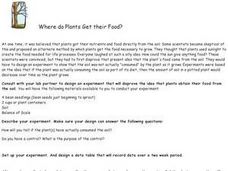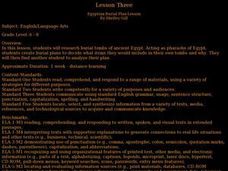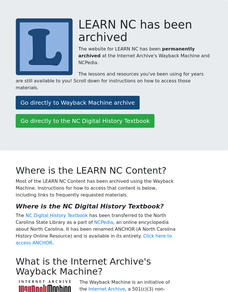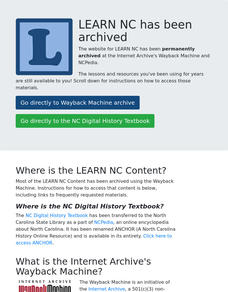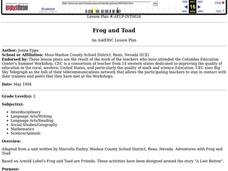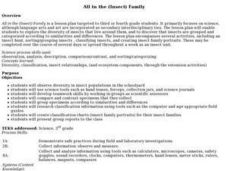Curated OER
A New Slant On The Seasons
Students identify how the tilt and position of the Earth causes the seasons. After a discussion of the seasons and when they begin. Using themselves as the objects in the universe, they role play how the rotational movement of the...
Curated OER
Where Do Plants Get Their Food?
Plants need food to survive, just like any other living organism. Young biologists analyze an experiment performed in 1610 by Jan van Helmont to determine if plant nutrition is obtained through the soil. First, lab groups work together...
Curated OER
Amate Bark Paintings/Folk Arts of Latin America
Students explore the history of bark paintings in South America and produce their own version of these paintings.
Curated OER
Entertainment and Recreation in the Early Twentieth Century and Today
Eleventh graders research entertainment and recreation in the early twentieth century using primary sources and the book From the Hidewood, by Robert Amerson. They compare the rural experience of the time period to the national...
Curated OER
Egyptian Burial
Middle schoolers research burial tombs of ancient Egypt. Acting as pharaohs of Egypt, students create burial plans to decide what items they would include in their own tombs and why. They find another student to analyze their plan.
Curated OER
Simulations
Students utilize simulation methods and other teaching strategies within elementary-level social studies classrooms. They identify methods of delivering social studies content that enables learners with special needs to learn from and...
Curated OER
A Photosynthesis Timeline
Science learners discover that scientific advancements come in increments. Beginning as an idea, changes and developments are influenced by available resources and current societal values. As an example, pupils examine the conclusions...
Curated OER
Cookie Topography
Students construct a cross section diagram showing elevation changes on a "cookie island." Using a chocolate chip cookie for an island, they locate the highest point in centimeters on the cookie and create a scale in feet. After tracing...
Curated OER
Community Treasures (Rivers and Trees): An Integrated Curriculum Unit
Third graders demonstrate an understanding of geography and its effects on lifestyles and culture. Then they apply basic economic terms and principles
and identify the United States government and history. Students also identify and...
Curated OER
A Picture's Worth 1000 Words: Decoding Intercultural Symbols
Students interpret a set of pictographs, defining what each image means and create their own set of symbols as an alphabet. They then write using their own symbolic alphabet using pictures.
Curated OER
1900 America: Historical Voices, Poetic Visions
Students examine the United States at the turn of the century. Using primary source documents, they interpret them within a specific historical context. Using this information, they write a poem with metaphors and a specific meter They...
Curated OER
Jewelry: Then and Now
Fifth graders identify specific works of art as belonging to particular cultures, times, & places, recognize & apply elements of art, learn techniques for working with each material, critique artwork, & discuss how artwork...
Curated OER
Inventing and Presenting Unit 3: Persuasive Speaking and Invention Promotion
Middle schoolers write a proposal for a speech. Students prepare appropriate visuals for use in the proposed speech. Middle schoolers produce one or more graphs that summarize the results from the experimentation. Students deliver an...
Curated OER
Inventing and Presenting Unit 2: Effective Speeches and Building the Invention
Young scholars identify the characteristics of effective speeches. Students find elements of good speeches in the text and in the delivery of model speeches. Young scholars build a working three-dimensional model of an invention or an...
Curated OER
Hey, I've Got A Question!
Seventh graders explore the Solar System. They develop a research question and use inquiry-based research skills to find the answers to their questions. Students write up their findings and create a multimedia presentation.
Curated OER
African Amercan Images in Harlem (1920-1950)
Eleventh graders compare and contrast different representations of African Americans in Harlem using visual sources. They detect point of views, themes, contradictions and ironies in sources using designed templates.
Curated OER
Relating Division and Subtraction
Third graders relate the process of division to subtracting equal groups. Through guided practice and teacher demonstration, they complete division problems using a subtraction method. Students complete problems independently for...
Curated OER
Fifties/Sixties Musical Playwriting Workshop
Students write a coherent script based on characterization, theme, conflict and emotional tone as found in the songs' lyrics and develop an understanding of the enjoyment that comes through discipline and hard work leading toward a...
Curated OER
What Can I Do About Global Environmental Change?
Students complete a unit to evaluate their impact on the environment and greenhouse gas emissions. They conduct Internet research, develop a list of their electrical and energy use, calculate their share of greenhouse gases, and identify...
Curated OER
Defining Regions
Fifth graders will work in cooperative learning groups to research North American regions and create presentations to share with their classmates. To show what they have learned, 5th graders will create maps of North American regions.
Curated OER
Asian, African, or Australian Inventors & Inventions
Seventh graders explore the inventors or inventions from Asia, Africa, and Australia.
Curated OER
Frog and Toad
Second graders learn vocabulary and use of words, set, attribute Venn diagram. They learn to describe attributes.
Curated OER
All in the (Insect) Family
Students participate in a series of activities in order to explore the diversity of insects. They explore how insects are grouped and categorized.
Curated OER
Masks and More Masks
Students study different cultures through their masking traditions. They experiment with a variety of mask making media. They explore the elements of 3-D to encourage creativity.



